Flexural Performance of Novel Nail-Cross-Laminated Timber Composite Panels
Abstract
1. Introduction
2. Experimental Program
2.1. Test Specimens
2.2. Test Setup and Experimental Procedures
3. Experimental Results and Analysis
3.1. General Behavior
3.2. Load Resistance and Failure Modes
3.3. Effects of Different Panel Design Parameters
3.3.1. Effect of Nailing Angle
3.3.2. Effect of Nail Type
3.3.3. Effect of Number of Nails
3.3.4. Effect of Number of Nailed Layers
3.4. Ultimate Bending Capacity
3.4.1. Calculation for 3-Layer CLT Panels
3.4.2. Calculation for 5-Layer CLT Panels
4. Conclusions
- NCLT panels are characterized by tensile failure. The stress-carrying process of NCLT panels is divided into elastic phase and elastic-plastic phase. The elastic phase typically extends longer compared to the elastic-plastic phase.
- The failure mode of NCLT panels depends on the angle, type, and quantity of nails. When the nailing angle was 30° or larger (less than 45), cracks mainly developed along the transverse direction; when the nail type was threaded nails and screws, cracks mainly develop along the direction of the grain; when the number of nails was larger, cracks developed primarily along the horizontal direction.
- Comparing the theoretically calculated bending capacity of NCLT panels to corresponding experimentally measured values, the test values for three-layer NCLT panels were larger than the theoretical values. Hence, the bending moment calculation formula for CLT panels can be corrected with a nail connection influence coefficient α = 1.33.
- The effective bending stiffness of NCLT panels was positively correlated with the force between layers. Strong interactions between panel layers improved the bending stiffness, and the interaction between the layers was positively related to the nail pullout force. The greater the nail pullout force, the greater was the force between the layers.
- From the nailing angle analysis, 30° nailing angle increased inter-panel force, and the ductility of NCLT panels also increased by 2.27%. The 30° nailing mitigated both the cocking of the wood slabs during damaged and the development of rupture cracks along the direction of the grain.
- In terms of the type of nailing, the damage was ranked from worst to least in the order: polished rod NCLT panels, threaded nail NCLT panels, and screw NCLT panels. The ultimate bearing capacity was 47.96 kN, 58.46 kN, and 45.46 kN for the polished rod nail NCLT panels, threaded nail NCLT panels, and screw NCLT panels, respectively.
- The increase in number of nails seemed to cause stress concentration in weak parts of the NCLT panels but also enhanced the interlaminar connection force, which was beneficial to improving the effective bending stiffness of the NCLT panels.
- The effective bending stiffness increased with the number of nailed layers, and the deformation rate of the wood at the bottom tensile zone was greatly decreased. Under the same displacement, the force performance and the damage form were both greatly increased with increased number of nailed layers.
- NCLT panels are more sustainable and more resilient compared to conventional glued CLT panels. Hence, NCLT panels can be a strong contender for diverse structural applications. This work should blaze the trail for further research towards the development of pertinent design provisions for NCLT panels and their wide implementation in full-scale construction.
Author Contributions
Funding
Conflicts of Interest
References
- Brandner, R. Cross laminated timber (CLT) in compression perpendicular to plane: Testing, properties, design and recommendations for harmonizing design provisions for structural timber products. Eng. Struct. 2018, 171, 944–960. [Google Scholar] [CrossRef]
- Betti, M.; Brunetti, M.; Lauriola, M.P.; Nocetti, M.; Ravalli, F.; Pizzo, B. Comparison of newly proposed test methods to evaluate the bonding quality of Cross-Laminated Timber (CLT) panels by means of experimental data and finite element (FE) analysis. Constr. Build. Mater. 2016, 125, 952–963. [Google Scholar] [CrossRef]
- Ahmed, S.; Arocho, I. Emission of particulate matters during construction: A comparative study on a Cross Laminated Timber (CLT) and a steel building construction project. J. Build. Eng. 2019, 22, 281–294. [Google Scholar] [CrossRef]
- Jones, K.; Stegemann, J.; Sykes, J.; Winslow, P. Adoption of unconventional approaches in construction: The case of cross-laminated timber. Constr. Build. Mater. 2016, 125, 690–702. [Google Scholar] [CrossRef]
- Xu, S. A Review on Cross Laminated Timber (CLT) and Its Possible Application in North America; University of British Columbia Library: Vancouver, BC, Canada, 2013; Available online: http://hdl.handle.net/2429/45502 (accessed on 13 November 2018).
- Lehringer, C.; Gabriel, J. Review of recent research activities on one-component pur-adhesives for engineered wood products. In Materials and Joints in Timber Structures; Reinhardt, H.W.S., Garrecht, H., Eds.; RILEM Bookseries; Springer: Dordrecht, The Netherlands, 2014; Volume 9, Available online: https://doi.org/10.1007/978-94-007-7811-5_37 (accessed on 8 October 2018).
- Amini, M.O.; Van De Lindt, J.; Rammer, D.R.; Pei, S.; Line, P.; Popovski, M. Systematic experimental investigation to support the development of seismic performance factors for cross laminated timber shear wall systems. Eng. Struct. 2018, 172, 392–404. [Google Scholar] [CrossRef]
- Mayencourt, P.; Mueller, C. Structural optimization of cross-laminated timber panels in one-way bending. Structures 2019, 18, 48–59. [Google Scholar] [CrossRef]
- He, M.; Sun, X.; Li, Z. Bending and compressive properties of cross-laminated timber (CLT) panels made from Canadian hemlock. Constr. Build. Mater. 2018, 185, 175–183. [Google Scholar] [CrossRef]
- Pilon, D.S.; Palermo, A.; Sarti, F.; Salenikovich, A. Benefits of multiple rocking segments for CLT and LVL Pres-Lam wall systems. Soil Dyn. Earthq. Eng. 2019, 117, 234–244. [Google Scholar] [CrossRef]
- Jiang, Y.; Crocetti, R. CLT-concrete composite floors with notched shear connectors. Constr. Build. Mater. 2019, 195, 127–139. [Google Scholar] [CrossRef]
- Nairn, J.A. Cross laminated timber properties including effects of non-glued edges and additional cracks. Eur. J. Wood. Wood. Prod. 2017, 75, 973–983. [Google Scholar] [CrossRef]
- Chen, C.X.; Pierobon, F.; Ganguly, I. Life Cycle Assessment (LCA) of Cross-Laminated Timber (CLT) produced in Western Washington: The role of logistics and wood species mix. Sustainability 2019, 11, 1278. [Google Scholar] [CrossRef]
- Ataei, A.; Chiniforush, A.; Bradford, M.; Valipour, H. Cyclic behaviour of bolt and screw shear connectors in steel-timber composite (STC) beams. J. Constr. Steel Res. 2019, 161, 328–340. [Google Scholar] [CrossRef]
- Chiniforush, A.; Valipour, H.; Bradford, M.; Akbarnezhad, A. Long-term behaviour of steel-timber composite (STC) shear connections. Eng. Struct. 2019, 196, 109356. [Google Scholar] [CrossRef]
- Schmidt, E.L.; Riggio, M.; Barbosa, A.R.; Mugabo, I. Environmental response of a CLT floor panel: Lessons for moisture management and monitoring of mass timber buildings. Build. Environ. 2019, 148, 609–622. [Google Scholar] [CrossRef]
- Hassanieh, A.; Valipour, H.; Bradford, M.A. Load-slip behaviour of steel-cross laminated timber (CLT) composite connections. J. Constr. Steel Res. 2016, 122, 110–121. [Google Scholar] [CrossRef]
- Jacquier, N.; Girhammar, U.A. Tests on glulam-CLT shear connections with double-sided punched 431 metal panel fasteners and inclined screws. Constr. Build. Mater. 2014, 72, 444–457. [Google Scholar] [CrossRef]
- China Standards. GB 50010-2002: Code for Design of Concrete Structures; China Building Science Academy: Beijing, China, 2002. [Google Scholar]
- Karacabeyli, C.E.; Pirvu, C.L.T. Handbook: Cross-laminated timber; FP Innovations: Quebec City, QC, Canada, 2019; pp. 1–45. [Google Scholar]
- European Standard Norme Europeenne Europaische Norm. EN 1995-1-1 (English): Eurocode 5: Design of Timber Structures—Part 1–1: General-Common Rules and Rules for Buildings; The European Union Per Regulation: Stockholm, Sweden, 2004. [Google Scholar]
- European Standard Norme Europeenne Europaische Norm. En BS. 1-2: 2002 Eurocode 1: Actions on Structures—Part 1–2: General Actions—Actions on Structures Exposed to Fire; British Standards: Brussels, Belgium, 2002. [Google Scholar]
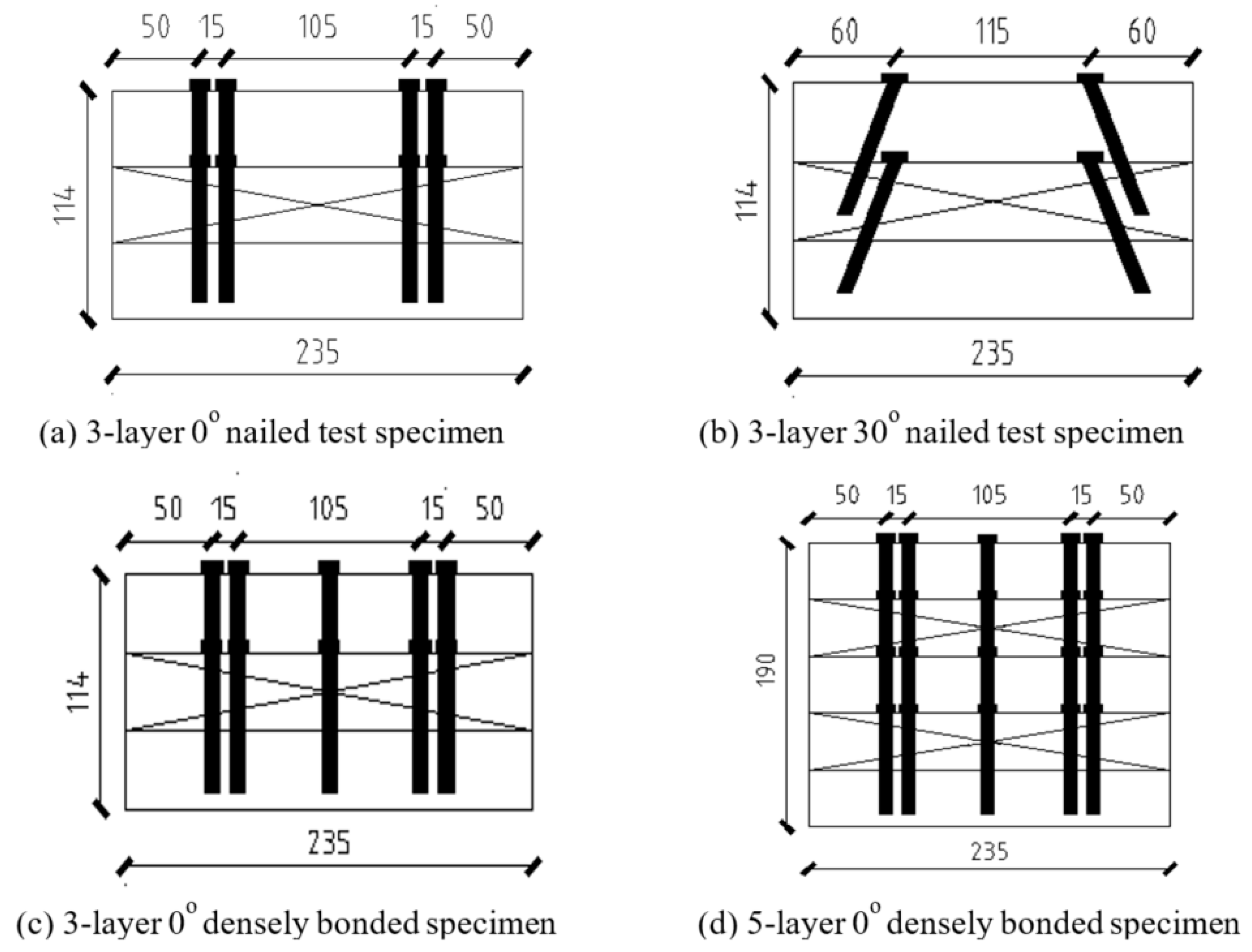

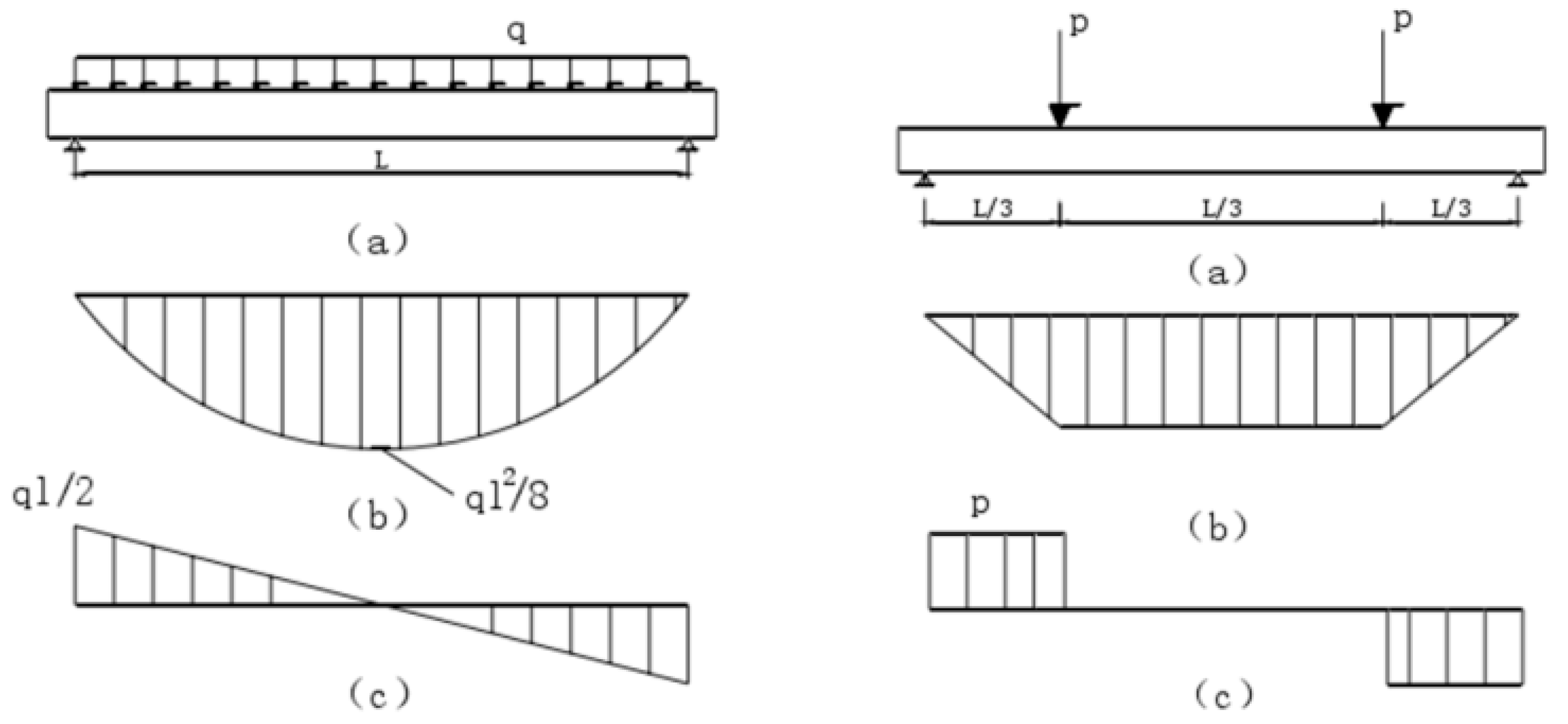



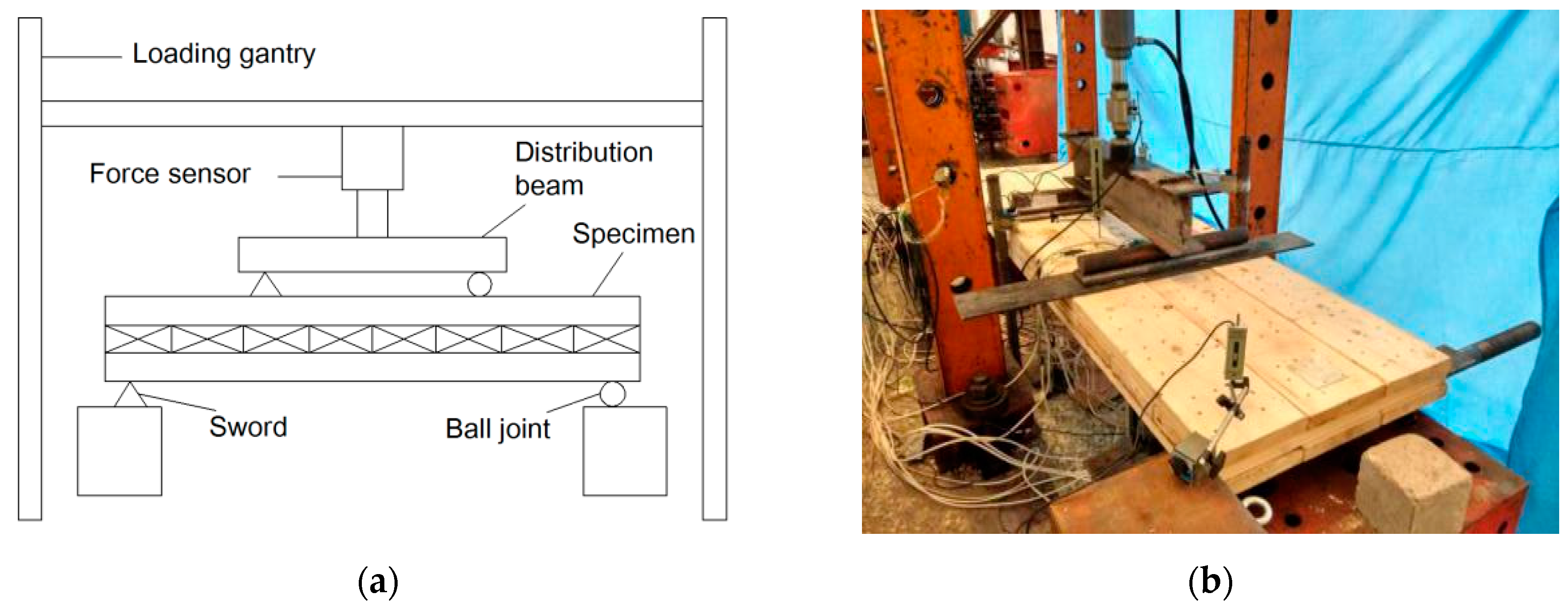
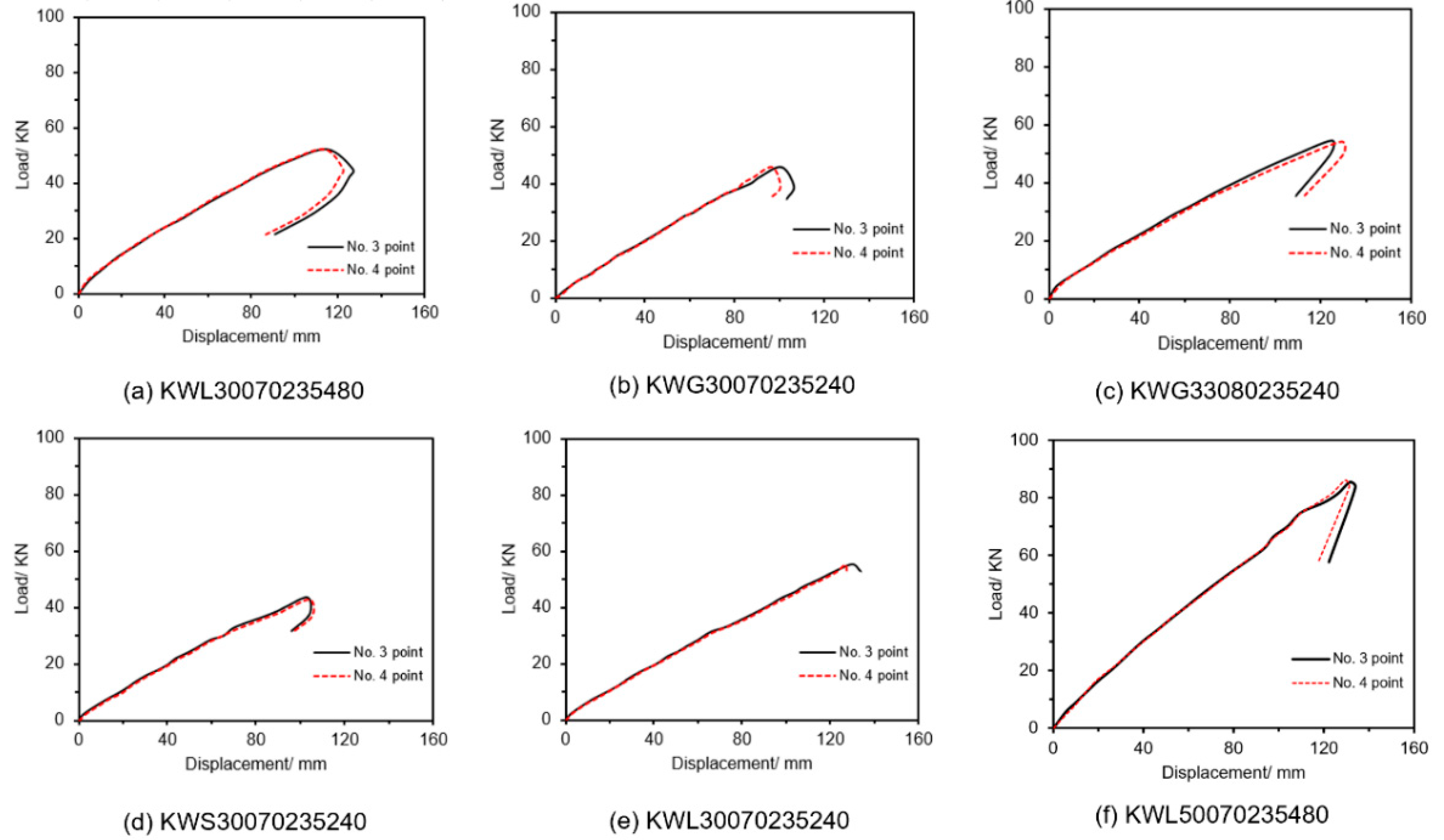
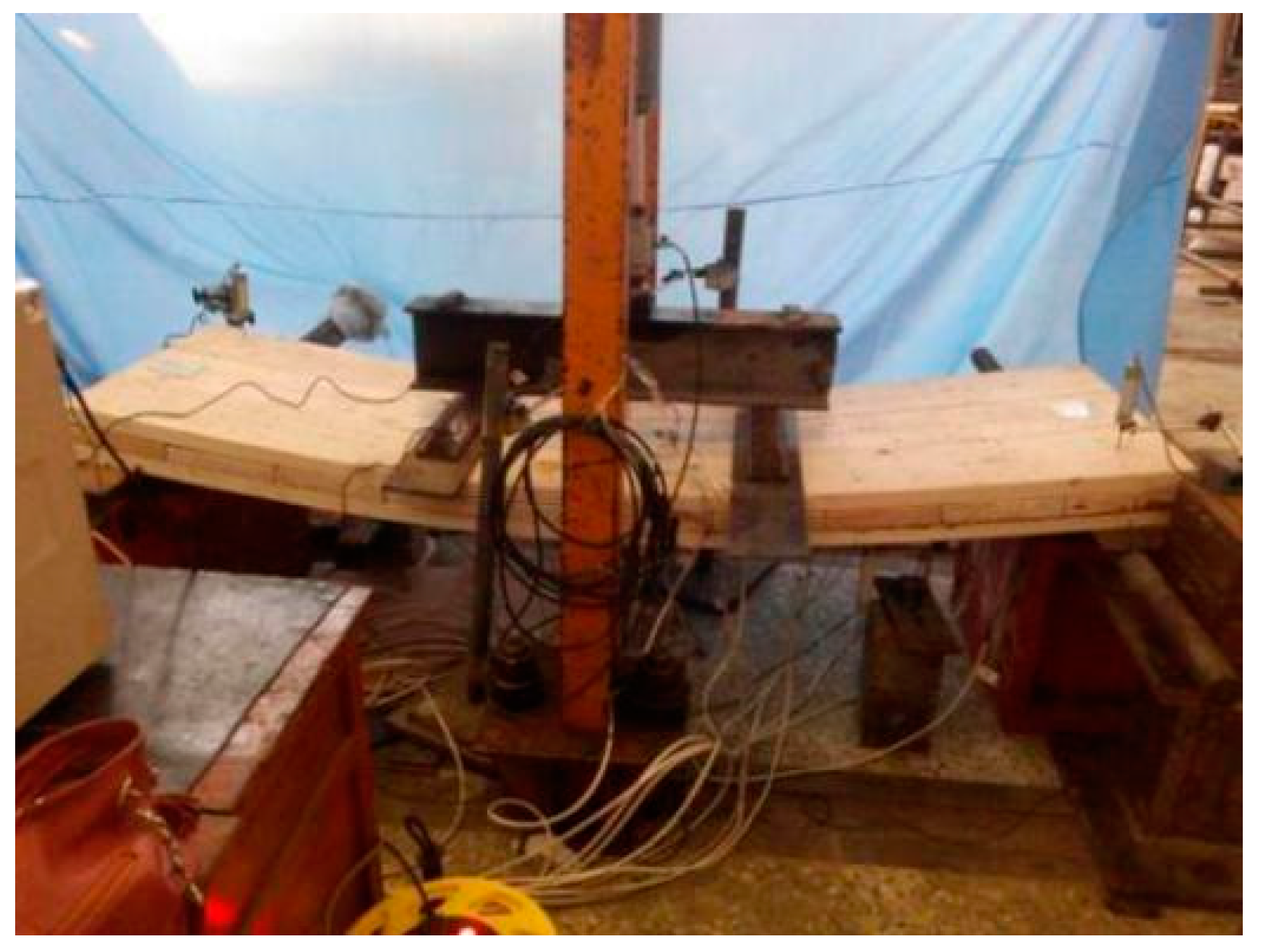
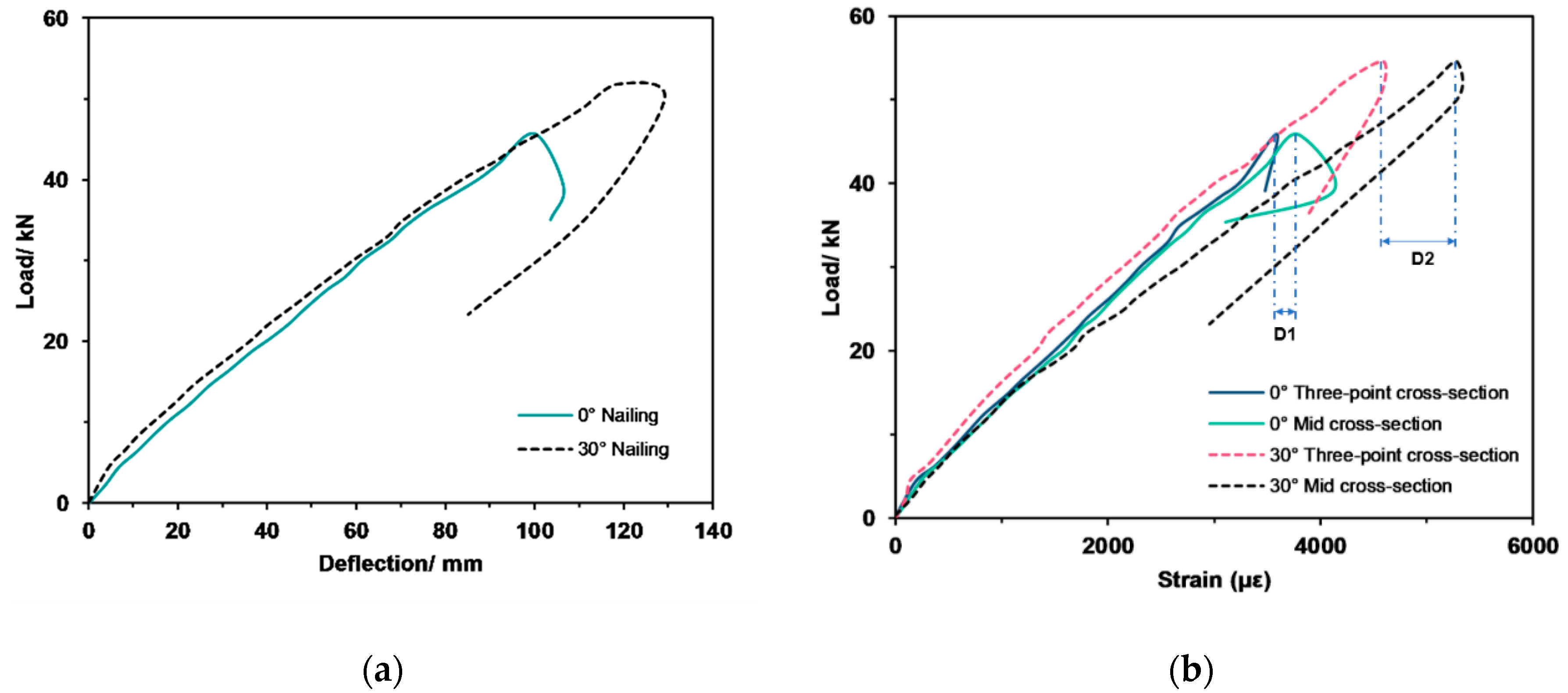

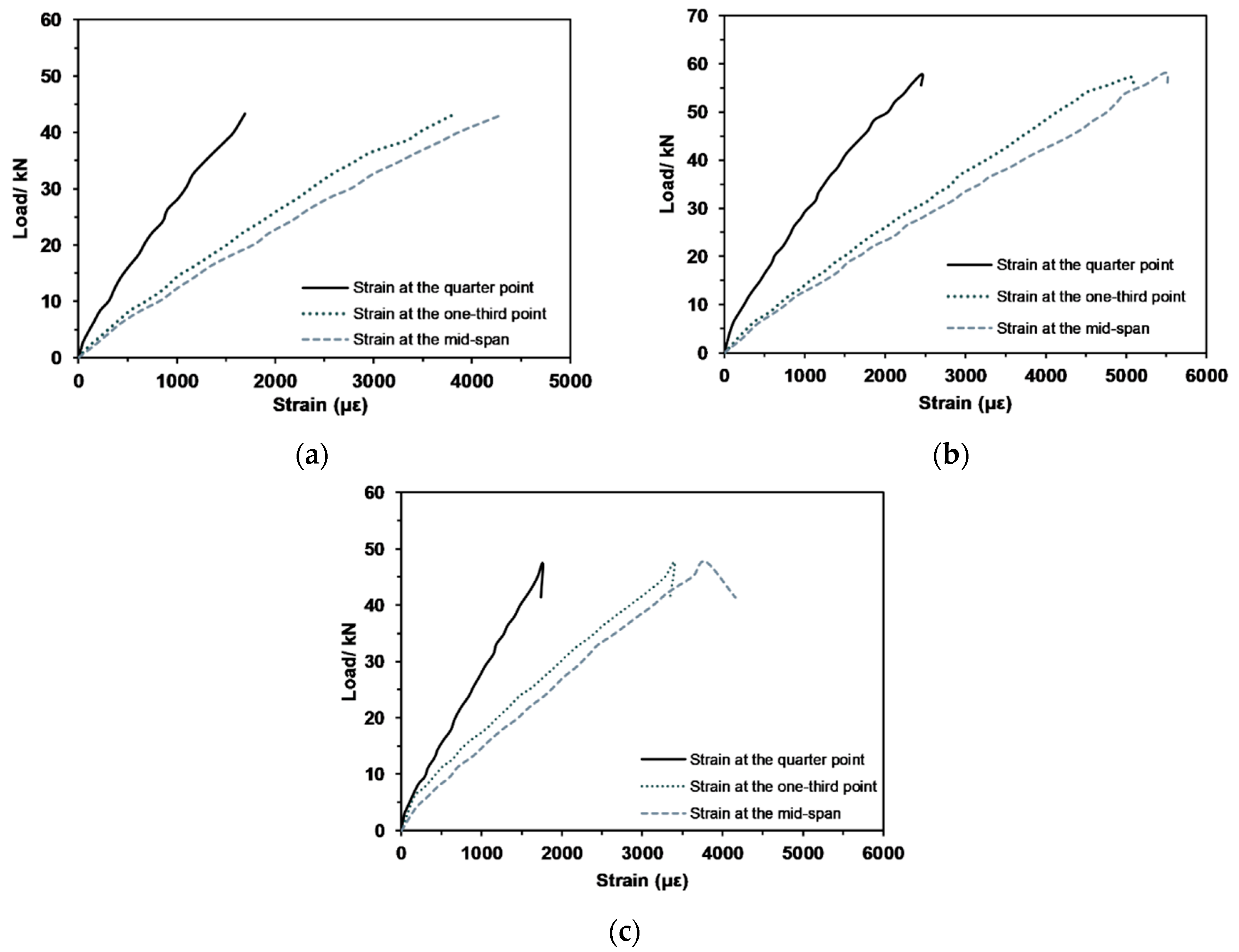

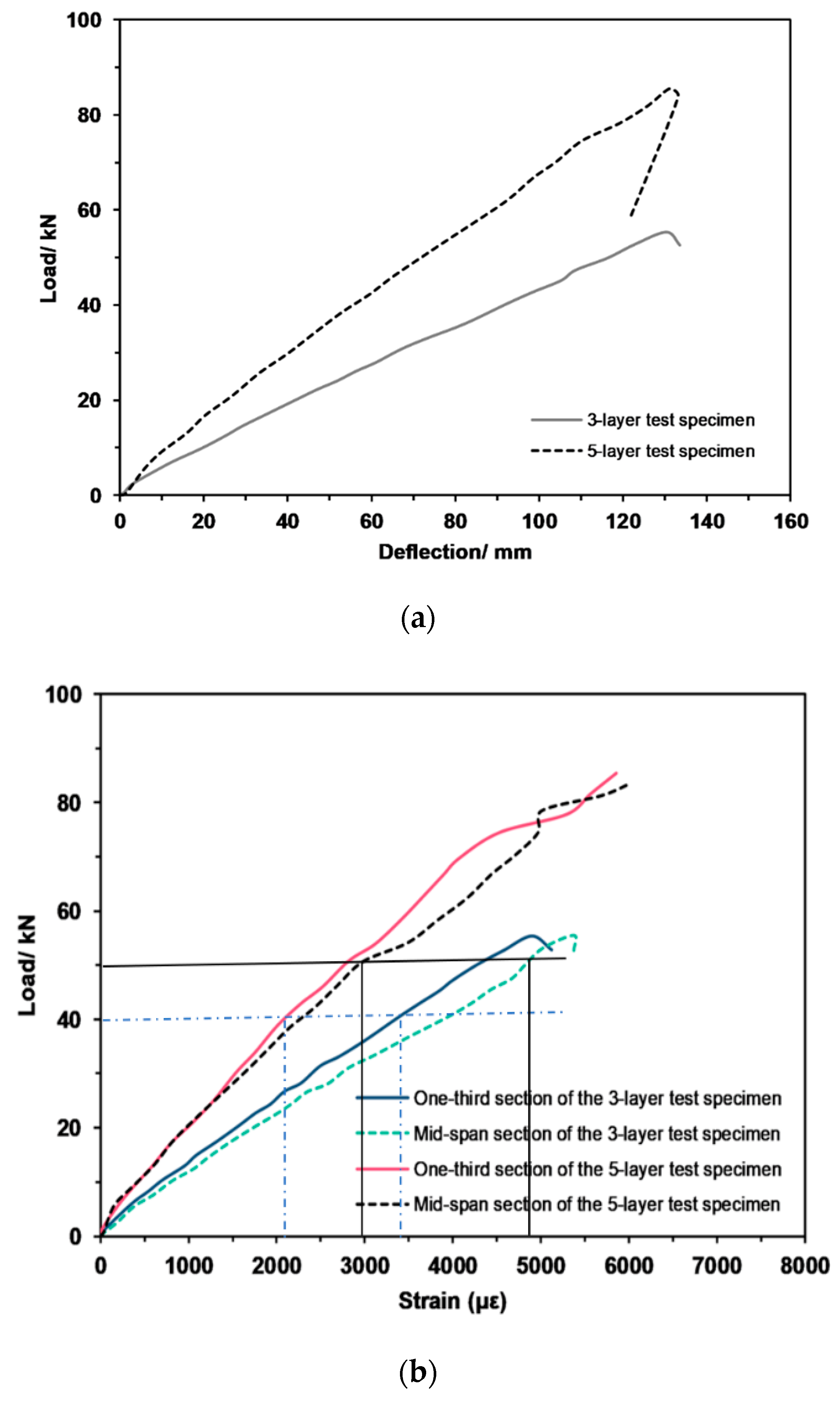


| Test Sequence | Specimen Number | Number of Layers | Nail Incidence Angle | Types of Nails | Nail Specifications\mm | Total Number of Nails | Size\mm |
|---|---|---|---|---|---|---|---|
| 1 | KWL30070235480 | 3 | 0° | Threaded nail | 2.5, 70 | 480 | 2350 × 705 × 114 |
| 2 | KWG30070235240 | 3 | 0° | Polished rod | 3.5, 70 | 240 | 2350 × 705 × 114 |
| 3 | KWG33080235240 | 3 | 30° | Polished rod | 3.5, 80 | 240 | 2350 × 705 × 114 |
| 4 | KWS30070235240 | 3 | 0° | Screw | 3.0, 70 | 240 | 2350 × 705 × 114 |
| 5 | KWL30070235240 | 3 | 0° | Threaded nail | 2.5, 70 | 240 | 2350 × 705 × 114 |
| 6 | KWL50070235480 | 5 | 0° | Threaded nail | 2.5, 70 | 480 | 2350 × 705 × 114 |
| Species | Bending Strength/MPa | Horizontal Texture Compressive Strength/MPa | Vertical Texture Compressive Strength/MPa | Tensile Strength/MPa | Elastic Modulus/103 MPa | Density (kg/m3) | Water Content (%) |
|---|---|---|---|---|---|---|---|
| Spruce | 12.5 | 37.8 | 4.1 | 92.39 | 11.2 | 430 | 15 |
| Pine | 10.9 | 43.2 | 3.6 | 83.66 | 10.9 | 455 | 15 |
| Fir | 12.1 | 38.9 | 3.8 | 88.26 | 11.4 | 440 | 15 |
| Specimen Label | Maximum Mid-Span Displacement/mm | Bearing Capacity/kN | ||||
|---|---|---|---|---|---|---|
| No. 3 Measuring Point | No. 4 Measuring Point | Average Value | F | Fmax | F/Fmax | |
| KWL30070235480 | 126.44 | 121.74 | 124.09 | 44.9 | 52.0 | 0.85 |
| KWG30070235240 | 106.48 | 100.61 | 103.55 | 39.0 | 45.8 | 0.85 |
| KWG33080235240 | 124.58 | 129.67 | 127.13 | 49.9 | 54.4 | 0.92 |
| KWS30070235240 | 104.22 | 105.95 | 105.09 | 37.4 | 43.3 | 0.86 |
| KWL30070235240 | 133.54 | 127.84 | 130.69 | 52.7 | 55.2 | 0.95 |
| KWL50070235480 | 133.24 | 131.70 | 132.47 | 83.9 | 85.7 | 0.98 |
| Specimen Number | Ultimate Bearing Capacity/kN | Deflection/mm | Maximum Strain Value |
|---|---|---|---|
| KWG30070235240 | 47.96 | 106.42 | 4293 |
| KWL30070235240 | 58.46 | 133.72 | 5503 |
| KWS30070235240 | 45.46 | 104.22 | 3844 |
| Specimen | Moment Theoretical Calculation (Mr)/kN·m | Measured Bending Moment (Ms)/kN·m | Ms/Mr | (Ms − Mr)/Mr (%) |
|---|---|---|---|---|
| KWL30070235480 | 13.37 | 18.49 | 1.38 | 38.29 |
| KWG30070235240 | 13.37 | 16.30 | 1.22 | 19.45 |
| KWG33080235240 | 13.37 | 19.36 | 1.45 | 44.80 |
| KWS30070235240 | 13.37 | 15.41 | 1.15 | 15.26 |
| KWL30070235240 | 13.37 | 19.64 | 1.47 | 46.90 |
| KWL50070235480 | 31.98 | 30.49 | 0.92 | −4.66 |
| Specimen | Moment Theoretical Calculation/kN·m | Measured Ultimate Bending Moment/kN·m | Measured Bending Moment/Theoretical Bending Moment | (Measured Bending Moment—Theoretical Bending Moment)/Theoretical Bending Moment (%) | α |
|---|---|---|---|---|---|
| KWL30070235480 | 17.78 | 18.49 | 1.06 | 3.99 | 1.33 |
| KWG30070235240 | 17.78 | 16.30 | 0.92 | −8.32 | 1.33 |
| KWG33080235240 | 17.78 | 19.36 | 1.08 | 8.87 | 1.33 |
| KWS30070235240 | 17.78 | 15.41 | 0.87 | −13.33 | 1.33 |
| KWL30070235240 | 17.78 | 19.64 | 1.10 | 10.46 | 1.33 |
© 2020 by the authors. Licensee MDPI, Basel, Switzerland. This article is an open access article distributed under the terms and conditions of the Creative Commons Attribution (CC BY) license (http://creativecommons.org/licenses/by/4.0/).
Share and Cite
Zhang, Y.; Nehdi, M.L.; Gao, X.; Zhang, L.V. Flexural Performance of Novel Nail-Cross-Laminated Timber Composite Panels. Appl. Sci. 2020, 10, 5983. https://doi.org/10.3390/app10175983
Zhang Y, Nehdi ML, Gao X, Zhang LV. Flexural Performance of Novel Nail-Cross-Laminated Timber Composite Panels. Applied Sciences. 2020; 10(17):5983. https://doi.org/10.3390/app10175983
Chicago/Turabian StyleZhang, Yannian, Moncef L. Nehdi, Xiaohan Gao, and Lei V. Zhang. 2020. "Flexural Performance of Novel Nail-Cross-Laminated Timber Composite Panels" Applied Sciences 10, no. 17: 5983. https://doi.org/10.3390/app10175983
APA StyleZhang, Y., Nehdi, M. L., Gao, X., & Zhang, L. V. (2020). Flexural Performance of Novel Nail-Cross-Laminated Timber Composite Panels. Applied Sciences, 10(17), 5983. https://doi.org/10.3390/app10175983







